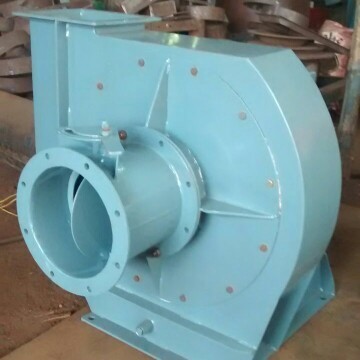A FAN is a device which is used to supply mechanical energy to the air or gas. There are two main kinds of industrial fans: 1. Centrifugal fans 2. Axial-flow fans CENTRIFUGAL FANS : Centrifugal fans consist of a wheel or a rotor mounted on a shaft that rotates in a scroll-shaped housing. Air enters at the eye of the rotor, makes a right-angle turn, and is forced through the blades of the rotor by centrifugal force into the scroll-shaped housing. The centrifugal force imparts static pressure to the air. The diverging shape of the scroll also converts a portion of the velocity pressure into static pressure. There are three main types of centrifugal fans: RADIAL BLADE FANS - Radial-blade fans are used for heavy dust loads. Their straight, radial blades do not get clogged with material, and they withstand considerable abrasion. These fans have medium tip speeds and medium noise factors. BACKWARD CURVED BLADE FANS - Backward-blade fans operate at higher tip speeds and thus are more efficient. Since material may build up on the blades, these fans should be used after a dust collector. Although they are noisier than radial-blade fans, backward-blade fans are commonly used for large-volume dust collection systems because of their higher efficiency. FORWARD CURVED BLADE FANS - These fans have curved blades that are tipped in the direction of rotation. They have low space requirements, low tip speeds, and a low noise factor. They are usually used against low to moderate static pressures. When we design fan for client, we consider the following points : 1. Volume required 2. Fan static pressure 3. Type of material to be handled through the fan (For example, a radial-blade fan should be used with fibrous material or heavy dust loads, and non-sparking construction must be used with explosive or inflammable materials.) 4. Type of drive arrangement, such as direct drive or belt drive 5. Space requirements 6. Noise levels 7. Operating temperature 8. Sufficient size to handle the required volume and pressure with minimum horsepower 9. Need for special coatings or construction when operating in corrosive atmospheres 10. Ability of fan to accommodate small changes in total pressure while maintaining the necessary air volume 11. Need for an outlet damper to control airflow during cold starts We at SGM TECH provide all types of fans according to client's requirement. We appreciate your interest in fans and request the enquiry for the future transactions.
